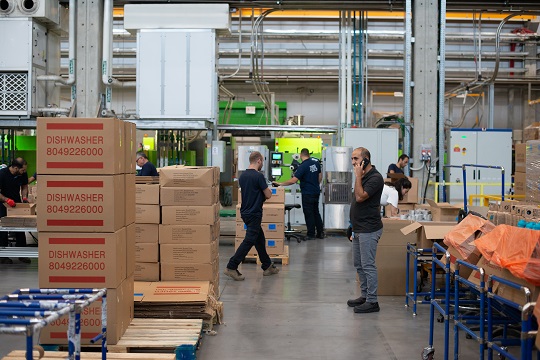Effective inventory management is crucial for businesses, impacting various aspects of their operations, such as efficiency, profitability, and customer satisfaction. Keeping accurate and up-to-date stock levels is vital for making informed decisions, allowing businesses to meet market demands, enhance order fulfillment, and avoid the risks of overstocking or stockouts.
Proper inventory management not only streamlines daily operations but also plays a significant role in a company’s financial health. Excess inventory ties up capital, while stockouts can lead to lost sales and erode customer trust. Customer satisfaction, a key driver of business success, relies on maintaining accurate inventory levels, as timely and precise order fulfillment builds customer loyalty.
Despite the importance of inventory management, businesses often struggle with inaccuracies during stocktaking. These inaccuracies can result from various factors, including human error, misplaced items, technological failures, and communication issues between departments. To establish and maintain a robust inventory management system, it is crucial for businesses to identify and address these causes comprehensively.
In this blog post, we will explore the top 10 causes of inventory inaccuracies, offering valuable insights and actionable strategies. By doing so, businesses can improve their inventory management practices, leading to sustained operational excellence and enhanced bottom-line performance.
Before we go further into this topic, don’t forget to follow my LinkedIn account. You’ll get more helpful insights on supply chain management there.
Table of Contents
Cause 1: Human Error
Human error poses a significant challenge in inventory management, creating issues that can disrupt the balance between recorded and actual inventory levels.
Counting errors, often stemming from the complexity of manually tallying large quantities of items, can lead to inaccuracies throughout the supply chain.
Recording errors, such as misinterpreting product codes or inefficiently updating inventory databases, contribute to discrepancies that undermine the reliability of inventory data. Even small typos during data entry can result in significant discrepancies, especially in high-volume transactions.

Miscalculations in determining reorder points or assessing demand forecasts further compound the difficulty of maintaining accurate inventory levels.
To mitigate the impact of human error, businesses need a comprehensive approach. Employee training programs are crucial for cultivating a workforce that understands the importance of precision in inventory management.
By educating staff on best practices, emphasizing attention to detail, and highlighting common pitfalls, businesses can empower their teams to contribute to accurate stock levels.
Implementing double-checking procedures, where a second set of eyes verifies critical inventory-related tasks, serves as a crucial safety net against undetected errors.
Technology solutions, such as barcode scanners, provide a sophisticated layer of accuracy by automating counting and data input processes.
Integrating these tools into inventory management systems not only reduces the likelihood of human error but also enhances operational efficiency by streamlining routine tasks.
Cause 2: Misplacement of Items
The misplacement of items in a warehouse or facility is a major factor contributing to inventory inaccuracies, making it challenging to maintain an organized and efficient inventory system.
When items are not in their designated locations, finding and counting them accurately during stocktaking becomes a time-consuming and error-prone task.
This issue is particularly common in larger facilities or warehouses with complex layouts, where the sheer volume of stored items and intricate storage arrangements increase the likelihood of misplacement.
To address the problem of misplacement, businesses should proactively implement a well-organized and clearly labeled storage system. This involves logically categorizing items, assigning specific locations, and ensuring that the entire workforce is familiar with the system.
Regular audits and inspections serve as crucial checkpoints to identify and rectify misplacements efficiently.
Conducting these audits allows businesses to regularly review the placement of items, correct any discrepancies, and reinforce the importance of maintaining the integrity of the storage system.
Moreover, leveraging technology such as inventory management software with real-time tracking capabilities can streamline the process. It provides businesses with instant insight into the location of each item and facilitates quick adjustments when misplacements are detected.
In summary, a systematic approach to storage organization, combined with regular checks and the use of technology, can significantly reduce the impact of misplacement on inventory accuracy.
Cause 3: Obsolete or Expired Items
Inefficiently handling expired or outdated products in inventory is an ongoing challenge that can introduce significant inaccuracies into stock levels.
Besides taking up valuable storage space, expired items can create differences between recorded and actual inventory levels, distorting the overall understanding of available stock.
This issue is especially crucial for businesses dealing with perishable goods or products with a limited shelf life.
The presence of expired items not only skews the inventory count but also poses a risk to product quality and customer satisfaction.
To tackle this challenge, businesses should establish a robust inventory management system that includes proactive measures for handling expiring or obsolete items.
Regular checks for expiration dates, integrated into routine stocktaking processes, can help identify products nearing the end of their shelf life.
Automatic alerts triggered by the inventory management system can notify relevant personnel in real-time, enabling timely action to remove or appropriately manage these items.
Clear labeling of products with expiration dates is fundamental to ensuring visibility, and implementing rotation strategies—where older stock is positioned at the front for faster consumption—can help prevent the accumulation of expired or obsolete stock in the first place.
By integrating these practices, businesses can not only maintain accurate inventory counts but also uphold product quality standards and strengthen customer trust.
You might also like:
- Top 10 Inventory Management Best Practices
- Unveiling the Hidden Costs: The Impact of Meaningless Actions on Waste in Supply Chain Management
Cause 4: Shrinkage and Theft
Shrinkage, which includes employee theft, shoplifting, and various types of inventory loss, poses a significant hurdle in keeping accurate inventory levels.
The difference between what’s recorded and the actual inventory due to shrinkage can be substantial, impacting a business’s profitability and operational efficiency.

Employee theft, in particular, can harm the internal dynamics of an organization, eroding trust and creating an unproductive work environment.
On the other hand, shoplifting is an external threat that directly affects revenue and the overall financial health of the business.
The cumulative impact of shrinkage can disrupt supply chain operations, strain relationships with suppliers, and hinder a company’s ability to efficiently meet customer demands.
To effectively address shrinkage, businesses need a comprehensive strategy. Implementing strict security measures, both technological and procedural, is crucial to deter theft.
Regular audits and thorough surveillance systems provide an extra layer of protection by closely monitoring inventory movements.
Employee training on ethical practices and the consequences of theft plays a vital role in fostering a culture of integrity within the organization.
By instilling a sense of responsibility and accountability, businesses can reduce the likelihood of internal theft and create an environment where employees actively contribute to maintaining accurate inventory levels.
In essence, a holistic approach that combines technology, procedural safeguards, and ethical training is vital to effectively tackle the multifaceted challenge of shrinkage in inventory management.
Cause 5: Supplier Errors
Mistakes in supplier shipments pose a significant threat to inventory accuracy by creating differences between the expected and actual quantities or types of products. These errors can happen for various reasons, like miscommunication, misinterpretation of orders, or inaccuracies in the supplier’s own inventory management system.
The impact of these discrepancies might not be immediately obvious, causing a ripple effect that challenges a business’s ability to maintain precise stock levels.
If left unnoticed, these errors can lead to overstocking or stockouts, resulting in potential financial losses, customer dissatisfaction, and operational inefficiencies.
To tackle the challenges linked to supplier errors, businesses should establish clear communication channels with their suppliers. This involves maintaining open lines of dialogue, clarifying order details, and ensuring that both parties have a shared understanding of inventory requirements.

Implementing a robust receiving process is equally crucial, involving meticulous checks and verifications when goods are received. Thorough inspections upon receipt help identify any discrepancies between the delivered items and the corresponding purchase orders.
Moreover, leveraging technology solutions, such as barcode scanning and inventory management software, enhances accuracy by automating the reconciliation process.
Automated systems can compare received inventory against the purchase order details, flagging any inconsistencies for immediate attention.
This integration of technology streamlines the reconciliation process, minimizes the likelihood of human error, and ensures that discrepancies are swiftly addressed to maintain accurate stock levels.
Cause 6: Technology Failures
Relying on technology in inventory management systems comes with the risk of malfunctions that can impact the accuracy of stocktaking processes.
Tools like barcode scanners, RFID systems, and inventory management software play a crucial role in automating and streamlining inventory tracking.
However, when these systems encounter issues, it can lead to errors in data capture, recording, and communication, resulting in inaccuracies in inventory levels.
Taking a proactive approach is key to addressing potential failures and minimizing their impact on inventory accuracy.
Businesses should prioritize regular maintenance schedules for their technology systems. This includes ensuring that hardware components, software applications, and communication interfaces are functioning optimally.
Timely updates to software and firmware are essential to patch vulnerabilities, enhance performance, and incorporate new features that improve the overall reliability of the technology infrastructure.
Employee training is equally important in mitigating technology-related inaccuracies. Personnel using these systems should be well-versed in their operation, troubleshooting common issues, and understanding the importance of accurate data input.
Training programs empower employees to identify and address minor glitches efficiently, preventing them from escalating into larger inaccuracies.
Additionally, having backup systems in place is a smart strategy to maintain continuity during unexpected downtimes. These backup systems, whether redundant hardware or manual processes, act as contingency plans, ensuring that inventory management can continue even in the event of technology failures.
A comprehensive and proactive approach that combines regular maintenance, employee training, and contingency planning is essential for businesses relying on technology for accurate stocktaking and inventory management.
Cause 7: Unrecorded Transfers
The movement of items within a business, especially when it’s not properly documented, can create significant challenges in maintaining accurate inventory levels.
When these transfers go unrecorded, businesses run the risk of losing track of where items are during stocktaking processes.
Without precise records, it becomes tough to follow the movement of inventory throughout the organization, resulting in differences between the recorded and actual stock levels.
This lack of visibility not only hinders the efficiency of daily operations but also affects decision-making processes that rely on accurate inventory data.
To tackle the problem of unrecorded transfers, businesses should establish a centralized system for recording and tracking inventory movements.
This means putting in place standardized processes and protocols to document every transfer, ensuring that all relevant information is accurately captured.
Regular reconciliation processes, where recorded transfers are compared with physical counts, serve as a crucial checkpoint to identify and rectify discrepancies efficiently.
Clear communication protocols among different departments or locations are essential to ensure that everyone is informed and aligned with the documentation procedures.
By creating a transparent and standardized system for recording inventory transfers, businesses can improve their ability to maintain accurate stock levels, streamline internal operations, and make more informed decisions.
You might also like:
- Why Collaboration is More Important in Supply Chain Management Than Competition
- 15 Tips for Successful Supply Chain Beginners
Cause 8: Inaccurate Receiving
Mistakes during the receiving process can seriously jeopardize the accuracy of inventory counts, especially when dealing with a large volume of incoming shipments.
Failing to properly record received items can cause delays in updating inventory databases, resulting in a gap between the recorded and actual stock levels.

Adding to the problem, inaccuracies in data entry, such as typing errors in product codes or quantities, can create discrepancies that affect downstream inventory management processes. This issue becomes more common when handling a large number of shipments, as the sheer volume of transactions increases the chances of oversights and mistakes during the receiving process.
To reduce the impact of errors in the receiving process on inventory counts, businesses should implement various strategies to enhance accuracy.
Barcode scanning technology offers a streamlined and efficient way to capture data during receiving, minimizing the potential for human error in manual data entry.
When possible, automating data entry reduces reliance on manual input, speeding up the process and improving accuracy.
Conducting thorough inspections of received items, including visual checks and comparisons against purchase orders, serves as a crucial quality control measure to catch discrepancies early in the process.
Additionally, investing in training programs for receiving personnel is essential to ensure that staff are familiar with best practices, understand the importance of accuracy, and are proficient in using technology tools effectively.
By combining these measures, businesses can strengthen their receiving processes, enhancing overall accuracy in inventory counts and promoting a more efficient supply chain.
Cause 9: Seasonal Variations
Changes in demand due to different seasons can significantly affect inventory accuracy if not managed proactively.
Failing to anticipate and plan for seasonal variations can lead to imbalances in inventory levels, resulting in either having too much stock or running out of stock.
Having too much stock ties up valuable capital and increases the risk of products becoming obsolete, while running out of stock can mean missed sales opportunities and damage customer trust.
Seasonal demand spikes, like those during holidays or specific weather conditions, require a strategic approach to inventory management to meet customer expectations while maintaining operational efficiency.

To effectively handle seasonal variations in demand, businesses should use a mix of historical data, market trends, and advanced forecasting tools.
Analyzing past sales data from similar seasons, identifying patterns, and understanding the impact of external factors on demand can provide valuable insights for making informed decisions.
Forecasting tools, ranging from statistical models to machine learning algorithms, enable businesses to predict future demand more accurately.
Flexible inventory management systems that can adapt quickly to changing demand patterns are essential. These systems should allow for dynamic adjustments in stock levels, reorder points, and replenishment strategies based on real-time data and forecasted demand.
By integrating these approaches, businesses can optimize inventory levels, improve customer satisfaction, and maintain operational efficiency despite the challenges posed by seasonal variations in demand.
Cause 10: Poor Communication
The ineffective communication between different departments or shifts within an organization can pose a significant threat to inventory accuracy, especially when there are changes in inventory status.
Miscommunication can result in errors in recording, tracking, and managing inventory, causing disparities between recorded and actual levels.
For instance, if a product is moved from one storage location to another and this transfer is not accurately communicated, it can lead to confusion during stocktaking, where the recorded location may not match the actual one.
Similarly, changes in product availability, like restocks or depletions, may not be communicated efficiently across departments, resulting in discrepancies in inventory status.
To overcome communication challenges and improve accuracy in inventory management, businesses should implement various strategies.
Establishing clear protocols for inventory-related communication is crucial, ensuring standardized processes for conveying changes in inventory status, movements of goods, or any other relevant information.
Using collaborative tools, such as digital communication platforms or shared databases, facilitates real-time information sharing between departments and shifts.
Providing training on effective communication practices, especially those specific to inventory management, ensures that staff have the skills to convey information accurately and efficiently.
Regular meetings and updates serve as checkpoints to share important information, discuss changes in inventory procedures, and ensure that all relevant stakeholders are on the same page.
By promoting a culture of clear and effective communication, businesses can significantly reduce the risk of inaccuracies in inventory levels caused by miscommunication.
Conclusion
In summary, dealing with the top 10 causes of inventory inaccuracies isn’t just a reactive move; it’s a strategic necessity for businesses aiming to optimize their inventory management.
Having a thorough understanding of these factors empowers organizations to foresee and proactively tackle challenges before they become major issues, creating a more robust and accurate inventory management system.
By consistently addressing human error, misplaced items, obsolete products, shrinkage, supplier errors, technology failures, unrecorded transfers, inaccurate receiving, seasonal variations, and poor communication, businesses can establish a strong foundation for their supply chain operations.
The advantages of managing these inventory inaccuracies go beyond just improving accuracy. Successful mitigation leads to lower operational costs by reducing wastage, preventing overstocking or stockouts, and optimizing resource allocation.
Furthermore, the heightened accuracy in inventory levels results in improved overall efficiency throughout the supply chain.
With precise data guiding decision-making processes, businesses can streamline procurement, order fulfillment, and production processes, ultimately enhancing customer satisfaction.
In a competitive business environment where operational efficiency directly impacts profitability, addressing the root causes of inventory inaccuracies is a strategic necessity for sustainable success.
I hope you find it helpful!
Please share this article with your colleagues so they can also benefit. For more insights on supply chain management, follow my LinkedIn account. You’re free to use all articles on this blog for any purpose, even for commercial use, without needing to give credit.

 by
by 

